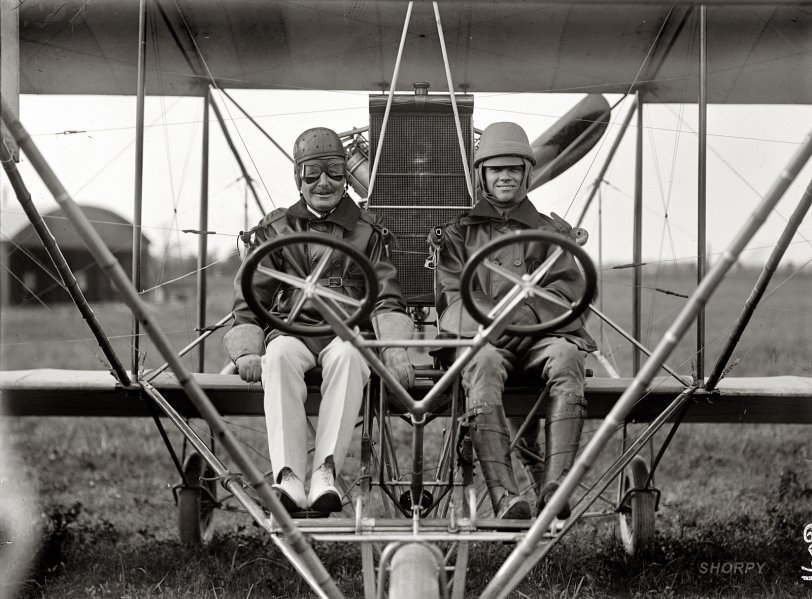


Framed or unframed, desk size to sofa size, printed by us in Arizona and Alabama since 2007. Explore now.
Shorpy is funded by you. Patreon contributors get an ad-free experience.
Learn more.

- Lost in Toyland
- And without gloves
- If I were a blindfolded time traveler
- Smoke Consumer Also Cooks
- Oh that stove!
- Possibly still there?
- What?!?
- $100 Reward
- Freeze Frame
- Texas Flyer wanted
- Just a Year Too Soon
- WWII -- Replacing men with women at the railroad crossing.
- Yes, Icing
- You kids drive me nuts!
- NOT An Easy Job
- I wonder
- Just add window boxes
- Icing Platform?
- Indiana Harbor Belt abides
- Freezing haze
- Corrections (for those who care)
- C&NW at Nelson
- Fallen Flags
- A dangerous job made worse
- Water Stop
- Passenger trains have right of way over freights?
- Coal
- Never ceases to amaze me.
- Still chuggin' (in model form)
- Great shot
Print Emporium
Fasten Your Seatbelts: 1912

1912. "Navy aviation. Commodore J.C. Gillmore in Curtiss headless plane, dual control, at College Park Army flying field. Lieutenant Milling, right." Harris & Ewing Collection glass negative, Library of Congress. View full size.
Death Spiral
I would just as soon share cigars with the consumption patients than go up in that contraption with The Wacky Commodore and his "ingenious" rope pedals.
Shoulder Tubes
I believe the tubes are control levers. Glenn Curtiss, the plane's designer, started out racing bicycles and motorcycles. It seemed perfectly natural for him that you'd make a plane turn by leaning to one side or the other, just like a bike.
Lt Milling
Interesting, at first I thought Lt Milling was US Navy but research shows he was US Army. In fact he was the first to receive a military flight certificate. He retired in 1933, brought back on active duty in 1942, retired again in 1946 as a Colonel. When he died in 1960, he was promoted to Brig General retroactive 1940. Not bad for a very youthful looking 24 year old.
Rope for the Commodore!
The poles are indeed is bamboo. But what I find the most interesting aspect of this photo is the rope tied across the bracing to allow the Commodore a way to anchor his feet. He apparently is too short to reach the struts. American (or Yankee) ingenuity in action!
Well-Earned Retirement
Commodore James Clarkson Gillmore had retired the previous year, following an eventful naval career. In the aftermath of the Spanish-American War, when the U.S. Navy was battling insurgents in the Philippines, Gillmore and 13 members of his crew on the USS Yorktown were captured in April 1899 and then abandoned in an area controlled by "murderous savages." Those who survived were rescued by American troops about eight months later. New York Times account of his rescue.
Headless Curtiss Pusher
If this a Curtiss Model D with the elevators mounted on the rear stabilizer rather than in front of the pilot (hence "headless") then the outrigger beams are indeed made of bamboo although most of the construction was done with spruce and the engine bearers and undercarriage beams were done in ash with doped linen over it. Treated bamboo is a good choice because it's durable and and flexible. I'm not sure about the construction details of the Curtiss Model E, which was the first aircraft purchased by the US Navy.
Struts
Are the struts on this plane bamboo?
Straps
Notice the shoulder straps attached to the tubing. I suppose that is to help them sit upright. With no cockpit or even a windscreen I guess that was a necessity. But I see no straps on their feet or legs. The whole contraption looks so flimsy, it only emphasizes how it took a fair measure of guts to fly one of those things.
College Park Flying Field
College Park Flying Field went into operation in 1909 when Wilbur Wright began training military pilots there, and is still in operation as College Park Airport, the oldest in the world. Since it is only seven minutes flying time from the Capitol, it has suffered seriously since 2001, with security measures driving general aviation elsewhere. There's a nice museum there, a decent restaurant, and a small park at the end of the runway where most mornings you can find me walking my dogs.
The Commodore
The Commodore appears to be wearing his dress whites. I guess he was going to the Officers Club after he was done tooling around in his flying machine.
The Commodore rank comes and goes. It falls between Captain and Rear Admiral and was last used during WWII. It signified an officer that commanded more than one ship.
























On Shorpy:
Today’s Top 5